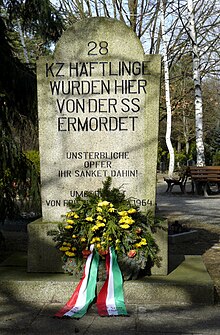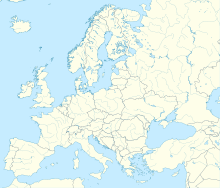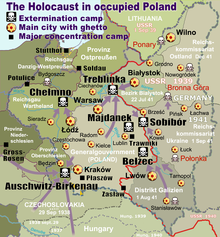Groß-Rosen concentration camp
Groß-Rosen concentration camp in Lower Silesia
|

The Groß-Rosen concentration camp was a German concentration camp in Lower Silesia in what is now Poland . It was located on the railway line from Jauer to Striegau 2.5 km southwest of Groß Rosen and 60 km southwest of Breslau . Between 1940 and 1945 around 130,000 people were imprisoned in the Groß-Rosen concentration camp, around 40,000 of whom were murdered.
history

The camp was set up on August 2, 1940 as a sub-camp of Sachsenhausen concentration camp by inmates from Sachsenhausen. In March 1941, construction of the small camp with four blocks began. From April 30, 1941, it was no longer a sub-camp; from May 1, 1941, the concentration camp was under its own administration.
The commanders were Arthur Rödl , Wilhelm Gideon and Johannes Hassebroek .
As of October 1941, the commandant's departments were staffed as follows: Commandant's staff with SS-Oberscharführer Eugen Illig; the Political Department (Gestapo) Criminal Secretary Richard Treske; Protective custody camp management with SS-Untersturmführer Anton Thumann , SS-Obersturmführer Walter Ernstberger ; the site administration with SS-Oberscharführer Willi Blume; Department V (medical services) with SS-Untersturmführer Friedrich Entress , SS-Hauptscharführer Karl Babor , SS-Hauptsturmführer Wilhelm Jobst , SS-Obersturmführer Heinrich Rindfleisch , SS-Hauptsturmführer Dehnel, SS-Hauptsturmführer Heinz Thilo and Josef Mengele .
The construction of the Great Camp, with an original capacity for 7,000 prisoners, but increased to 20,000, was completed by the beginning of 1944. At this point in time, the Groß-Rosen concentration camp was expanded again. The Auschwitz camp was planned for 45,000 prisoners and should be used for a relocation of the Auschwitz concentration camp because of the front shifts in the east.
Since 1943, the Gestapo in Breslau has also operated a labor education camp here .
The inmates of the main camp were used to mine granite in the Groß-Rosen quarries , which were exploited by the SS owned Deutsche Erd- und Steinwerke GmbH (DEST).

At the beginning of 1945 the SS evacuated the camp; the prisoners were deported or sent on death marches . Only a few prisoners remained and were liberated by the Soviet army on February 13, 1945 .
Concentration camp subcamps
Since 1942 the National Socialists began to expand various subcamps , so u. a. the Wroclaw (Lissa) labor camp. Further expansion began in 1944. Numerous sub-camps with over 100 external commandos served to bring cheap labor to the factories of the so-called war-important industry in Lower Silesia . There were also forced labor camps for Jews, e. B. in Dörnhau . These were taken over by the Schmelt organization . The nerve gases tabun and sarin were produced in the Dyhernfurth subcamp .
A large sub-camp was the Riese labor camp , which was made up of 4 large and 12 smaller camps. These were administered by the Todt Organization . Today it is estimated that a total of 13,300 people were housed in the satellite camps from 1943 to 1945, of whom 3,648 died. The guards consisted of around 900 people. Even after the liberation by the Red Army in 1945, many former concentration camp prisoners died as a result of their stay in the camp, so that a total of around 5,000 dead can be assumed.
Another satellite camp was the Brünnlitzer armaments factory of Oskar Schindler .
photos
See also
literature
-
Wolfgang Benz , Barbara Distel (ed.): The place of terror. History of the National Socialist Concentration Camps . 9 volumes. CH Beck, Munich 2005–, ISBN 978-3-406-52960-3 . ( Table of contents )
- 6: Natzweiler, Groß-Rosen, Stutthof. ISBN 978-3-406-52966-5 .
- Thomas Geve : There are no children here. Auschwitz, Groß-Rosen, Buchenwald. Drawings by a child historian. Edited by Volkhard Knigge (German, English, Hebrew). Göttingen 1997, ISBN 3-89244-220-7 .
- Willem Lodewijk Harthoorn: Verboden te sterven. (Dutch) ISBN 978-90-75879-37-7 . (Experiences of a Dutch communist who was imprisoned in Groß-Rosen from late April to mid-August 1942.)
- Alfred Konieczny: The Groß-Rosen concentration camp. In: Wolfgang Benz (Red.): "Dachauer Hefte 5 - The forgotten camps ", Munich 1994, ISBN 3-423-04634-1 .
- Isabell Sprenger: Groß-Rosen. A concentration camp in Silesia . Dissertation 1995 at the University of Stuttgart. Böhlau, Cologne 1996, ISBN 3-412-11396-4 .
- Andrea Rudorff: Women in the subcamps of the Groß-Rosen concentration camp. Metropol Verlag, Berlin 2014, ISBN 978-3-86331-162-9 , 440 pages.
- Nikolaus Wachsmann : KL: The history of the National Socialist concentration camps . Siedler Verlag, Munich 2016, ISBN 978-3-88680-827-4 .
Web links
- Gross-Rosen Museum
- Description and literature on shoa.de
- Materials on the Groß-Rosen concentration camp on learning from history
Individual evidence
- ^ Forced labor camp for Jews Dörnhau
- ↑ The Giant Complex (PDF; 215 kB)
Coordinates: 50 ° 59 ′ 50 ″ N , 16 ° 16 ′ 39.4 ″ E









